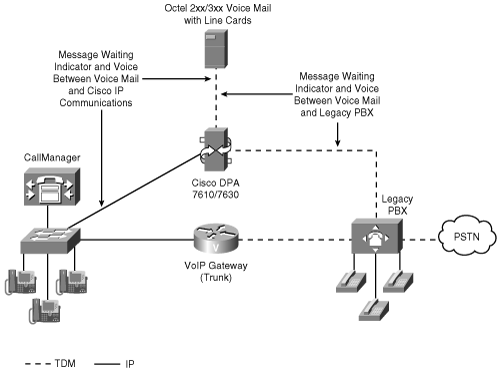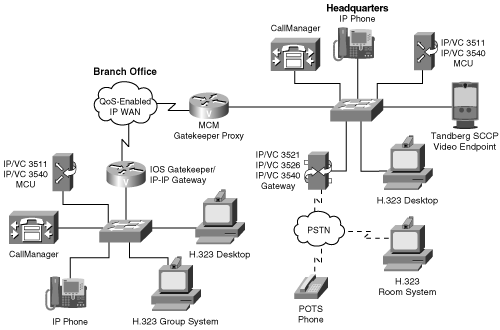Infrastructure Solutions
Infrastructure solutions include devices that provide media transport and manipulation, and connect the enterprise IP telephony networks to the PSTN and to other private telephone systems, such as PBX.
Cisco Analog Telephone Adaptors (ATA)
The Cisco ATA 186 and 188 Analog Telephone Adaptors are desktop hardware devices that interface legacy analog devices such as telephones, fax machines, and conference telephones to IP-based telephony networks. The Cisco ATA enables organizations to protect their investment in analog devices and to migrate to IP telephony at their own pace. Using a Cisco ATA, you can turn traditional telephone devices into IP devices that can take advantage of the many new and exciting IP telephony applications.
The Cisco ATA is installed at the end user's premises. Both the Cisco ATA 186 and 188 support two voice ports, each with its own independent telephone number. The Cisco ATA 186 has a single Ethernet port for upstream IP connectivity; the Cisco ATA 188 provides a second switched Ethernet port that supports a downstream device such as a PC. By turning any analog telephone into an IP phone, the Cisco ATA addresses the needs of the emerging market of "second-line" residential VoIP services as well as the needs of enterprise organizations that want to protect their investment in legacy analog equipment.
You can learn more about Cisco ATA models at the following link or search Cisco.com for "ATA":
http://www.cisco.com/en/US/products/hw/gatecont/ps514/index.html
Cisco DPA Voice Mail Gateways
Cisco DPA 7630 and 7610 are voice mail gateways that enable legacy voice mail equipment to connect to a Cisco IP Communications network. If you have an existing Octel 2xx or 3xx with digital line cards, you can use a Cisco DPA gateway to connect to CallManager without any changes to the voice mail system. The Cisco DPA 7630 allows the voice mail system to be used solely by CallManager or to be shared between CallManager and the PBX. Figure B-2 shows the Cisco DPA gateway integrated with a legacy PBX.
Figure B-2. Using Cisco DPA 7610/7630 with a Legacy PBX

Cisco DPA gateways communicate with CallManager by emulating IP phones using an auto-sensing 10/100 Ethernet port. Cisco DPA gateways communicate with the PBX and voice mail system using 24 digital station lines, and they are easily configured using a simple menu system accessed by Telnet. On the CallManager side, configuration is performed in CallManager Administration or automatically using auto-registration.
You can learn more about Cisco DPA voice mail gateways on Cisco.com at the following location or search Cisco.com for "Cisco DPA":
http://www.cisco.com/en/US/products/hw/gatecont/ps821/index.html
Cisco VG248 FXS or Voice Mail Gateway
The Cisco VG248 is a high-density gateway for using analog phones, fax machines, modems, voice mail systems, and speakerphones with a CallManager-based phone system. The Cisco VG248 provides supplementary services for analog phones, including hold, transfer, and conference. Using the Cisco VG248 Analog Phone Gateway, you can integrate your existing analog voice mail systems (which are compatible with Simple Message Desk Interface [SMDI], MCI, or Ericsson voice mail protocols) and legacy PBX systems with CallManager. The VG248 gateway provides voice mail systems with the information needed to intelligently process incoming calls, supply calling and called party identification, and set and clear message waiting indicators (MWI) through an EIA/TIA-232 serial connection.
The VG248 generates call information for all calls coming into any of the voice mail-enabled ports. The VG248 provides advantages to other methods used for integrating CallManager with analog voice mail systems, including the following:
- Reliability for voice mail links using CallManager failover
- Scalability by linking VG248 devices
- Flexibility to use multiple voice mail systems on a single cluster by using one VG248 per voice mail system, or use a single voice mail system on multiple clusters by using one VG248 per cluster, or a single voice mail system to be shared between CallManager and a legacy PBX
You can learn more about the Cisco VG248 at the following links or search Cisco.com for "VG200":
http://www.cisco.com/en/US/products/hw/gatecont/ps2250/index.html
http://www.cisco.com/univercd/cc/td/doc/product/voice/c_access/apg/index.htm
Cisco IP Videoconferencing (Cisco IP/VC)
The Cisco IP Videoconferencing (Cisco IP/VC) product family offers a flexible videoconferencing solution supporting the ITU H.323 standard and Skinny Client Control Protocol (SCCP). The Cisco IP/VC series includes audio and video bridges, also called multipoint conference units (MCU), which enable interactive collaboration between three or more endpoints. When used in a CallManager release 4.0 environment, these MCUs also provide bridging for videoconferences initiated by the Confrn or MeetMe softkeys on an IP phone equipped with a VT Advantage camera or a Tandberg SCCP endpoint. The IP/VC series also includes gateways that enable video calls between networks of IP-based video endpoints and ISDN-based H.320 videoconferencing systems. In addition, the T.120 data collaboration servers expand the capability of any videoconference to include application sharing, cooperative white boarding, and file transfer.
Cisco IP/VC products, and the solutions they enable, are developed for organizations that want a reliable, easy-to-manage, and cost-effective network infrastructure for videoconferencing applications deployment. Figure B-3 shows the Cisco IP/VC solution at work.
Figure B-3. Cisco IP/VC Solution

You can learn more about Cisco IP/VC in the Cisco IP Video Telephony Solutions Reference Network Design (SRND) guide, at the following links, or search Cisco.com for "IP/VC" or "SRND":
http://www.cisco.com/en/US/products/hw/video/ps1870/index.html
http://www.cisco.com/univercd/cc/td/doc/product/ipvc/index.htm
http://www.cisco.com/go/srnd
Note
If you already have substantial investments in H.320 videoconferencing, be aware that the H.323 standard enables interoperation with H.320-based systems. Furthermore, CallManager provides the protocol conversion to allow SCCP-based video endpoints, such as the Cisco VT Advantage solution and Tandberg SCCP video endpoints to also interoperate with H.320-based systems via the Cisco IP/VC H.320 gateways. Cisco IP/VC products enable an enterprise that has already experienced the benefits of videoconferencing over ISDN to leverage and protect its original investment while implementing new IP-based solutions.
Cisco Survivable Remote Site Telephony (SRST)
SRS Telephony provides a cost-effective, reliable mechanism for providing feature-rich call processing redundancy to enterprise branch offices while leveraging the existing branch office infrastructure. SRST comprises network intelligence integrated into Cisco IOS Software, which acts as the call processing engine for IP phones located in the branch office during a WAN outage. SRST is available on the Cisco 175x, 1760, 1800, 2600, 2800, 3600, 3700, 3800, and 7200 series multiple-service access routers and the Communication Media Module (CMM) on the Catalyst 6000, with more platforms continually being added.
You can learn more about SRST at the following links or search Cisco.com for "SRS Telephony":
http://www.cisco.com/en/US/products/sw/voicesw/ps2169/index.html
http://www.cisco.com/univercd/cc/td/doc/product/voice/srst/index.htm
Cisco CallManager Architecture
- Cisco CallManager Architecture
- Circuit-Switched Systems
- Enterprise Deployment of CallManager Clusters
- Regions
- Summary
Call Routing
- Call Routing
- The Three Responsibilities of Call Routing
- The Seven Fundamentals of Call Routing
- Route Patterns and Route Filters
- Dialing Transformations
- Translation Patterns
- Call Hunting Constructs
- Calling Search Spaces and Partitions
- Case Studies
- Miscellaneous Solutions
- International Numbering Plans
- Troubleshooting
- Summary
Station Devices
- Station Devices
- Definition of Station Devices
- Overview of Station Device Features Supported by CallManager
- Overview of Station Devices Supported by CallManager
- SCCP Station Devices
- Cisco VT Advantage
- Computer Telephony Interface (CTI) Devices
- H.323 Endpoint Devices
- Summary
Trunk Devices
- Trunk Devices
- Architectural Overview of Trunk Devices
- Overview of Circuit-Switched Interfaces
- VoIP Gateway Security
- H.323 Gateways
- MGCP Gateways
- SIP
- Summary
Media Processing
- Media Processing
- Media Processing Overview
- Architecture and Functionality of the Media Control Layer
- Ad Hoc Conferencing
- Meet-Me Conferencing
- Summary
Manageability and Monitoring
Call Detail Records
- Call Detail Records
- Overview of CDR Data
- Creation and Usage of CDR Data
- Storage and Maintenance of CDR Data
- Understanding Field Data in CDRs
- Understanding Field Data in CMRs
- Identifying CDR Data Generated for Each Call Type
- Accessing CDR Data in the Central CDR Database
- Hints on Processing CDR Data
- Troubleshooting CDR Data Generation and Storage
- Summary
Appendix A. Feature List
Appendix B. Cisco Integrated Solutions
- Appendix B. Cisco Integrated Solutions
- Infrastructure Solutions
- Telephony Service Solutions
- Client Solutions
- Application Solutions
- System Tools
Appendix C. Protocol Details
- Appendix C. Protocol Details
- H.323 Signaling
- QSIG
- SIP Signaling
- SCCP Call Signaling
- Application Protocols
Index
EAN: 2147483647
Pages: 141
